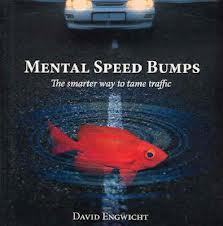Reclaiming Our Streets: A Model for Social Change
Mental Speed Bumps: A Smarter Way to Tame Traffic.
by David Engwicht, Envirobook 2005
Book Review
David Engwicht is an Australian social inventor who consults internationally with town planners and social engineers about traffic calming measures. Mental Speed Bumps describes a revolutionary bottom-up approach to traffic calming called “street reclaiming.” The main focus of street reclaiming is to reclaim city streets for people instead of motor vehicles.
Because of their immediate change effect, street reclaiming activities are extremely effective for inspiring optimism about political change. As well as helping to repair broken social networks, they encourage ordinary citizens to see themselves as change agents, rather than waiting for indifferent and/or corrupt political leaders to make changes on their behalf.
As Engwicht points out, most people tend to blame someone else – either city officials – or drivers from other neighborhoods – for their traffic problems. However on closer scrutiny, they usually discover that they and their neighbors are responsible for about one third of the traffic on their street.
The “Living Room” Analogy
Based on working with neighborhood activists all over the world, Engwicht recommends street reclaimers follow five basic steps:
1. Reclaim your street as a socializing space
Move some of your normal activities closer to the street (e.g. reading your book in your front yard or on the sidewalk – working on painting, refinishing, and other do-it-yourself projects in your parking space instead of your garage or basement).
Supervise children playing on the sidewalk or in the roadway.
Walk your kids to school
Walk to local destinations and greet people you encounter.
Hold a street party.
2. Move more slowly and gently
Reduce your own car use to a minimum.
If you must drive, do it more slowly and casually.
Teach your kids to walk or cycle to school.
3. Intrigue travelers by engaging them in the social life of the street.
Wave to motorists.
Put something intriguing, such as a veggie garden, in your front yard or parking strip
Blur the boundary between your private home and the street (e.g. take down your front fence and curtains). This is common in many European communities to maintain the street as a social space.
4. Work with neighbors to create “Linger Nodes” to facilitate social life in your street.
Create a socializing node on your private land (seating, drinking fountain community notice board, sculpture, etc) or on the sidewalk.
Encourage local businesses to connect with the street by placing an activity outside their premises.
5. Evolve your street from a "corridor" into a "room."
Put “furniture” and “art” in your room.
Work with your city on design elements that make your street feel more like a room (for example a landscaped entryway, a ceiling made of flags or banners, and walls created from furniture or art).
Examples of street reclaiming activities:
Above: Parking meter party (Vancouver)
photo credit: Andrew Curran via photopin cc
Below: Walking school bus (Montreal)
photo credit: Dylan Passmore via photopin cc
More free traffic taming information and materials available from Creative Communities
***
In celebration of read an ebook week, there are special offers on all my ebooks (in all formats) this week: they are free.
This includes my new novel A Rebel Comes of Age and my memoir The Most Revolutionary Act: Memoir of an American Refugee
Offer ends Sat. Mar 8.


The Most Revolutionary Act
- Stuart Jeanne Bramhall's profile
- 11 followers








